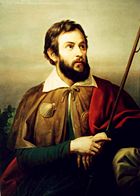Pilgrim

A pilgrim is one who undertakes a pilgrimage, literally 'far afield'. This is traditionally a visit to a place of some religious or historic significance; often a considerable distance is traveled. Examples include a Christian or Jew visiting Jerusalem or a Muslim visiting Mecca. No religion has laid greater stress on the duty of a pilgrim than Islam in the Hajj. In the United States the word "Pilgrims" usually refers to the European settlers of New England, who celebrated the "First Thanksgiving" with the Native Americans in 1621.
Contents |
Religious pilgrims


Pilgrims are common in many religions, including the faiths in ancient Egypt, Persia in the Mithraic period, India, China, and Japan. The Greek and Roman custom of consulting the gods at local oracles, such as those at Dodona or Delphi, both in Greece, is widely known. In Greece, pilgrimages could either be personal, or state-sponsored.[1]
In the early period of Hebrew history, pilgrims traveled to Shiloh, Dan, Bethel, and eventually Jerusalem, leading the way for the other Abrahamic religions to include the practice. The great Islamic pilgrimage to Mecca (now in Saudi Arabia), is obligatory for every able Muslim, and other Islamic devotional pilgrimages, particularly to the tombs of saints, are numerous. The early Christians made pilgrimages to the scenes of the Passion of Christ in Jerusalem. Even after Jerusalem had been occupied by the Saracens, the liberty of pilgrimage, on payment of a tax, was secured by treaty; the necessity of protecting pilgrims, however, gave rise to the medieval military orders, such as the Knights Templar.
While religious pilgrims usually travel toward a singular destination, a physical location is not a necessity. One group of pilgrims in early Celtic Christianity were the Peregrinari Pro Christ, (Pilgrims for Christ), or "white martyrs," where pilgrims left with the intent to wander.[2] This sort of pilgrimage was an ascetic religious practice, leaving home and the clan for an unknown destination, in complete trust of Divine Providence. These travels often resulted in the founding of new abbeys and spreading Christianity among the pagan population in Britain as well as on continental Europe.
Cultural pilgrims

A cultural pilgrimage, while also about personal journey, involves a secular response. Destinations for such pilgrims can include historic sites of national or cultural importance, and can be defined as places "of cultural significance: an artist's home, the location of a pivotal event or an iconic destination."[3] An example might be a baseball fan visiting Cooperstown, New York. Other typical global destinations for cultural pilgrims include Auschwitz concentration camp, Gettysburg Battlefield, the Ernest Hemingway House or even Disneyland.[3] Cultural pilgrims can also travel on religious pilgrimage routes, such as the Way of St. James, as a historic or architectural tour rather than a religious experience.[4]
Secular pilgrims are also found under communist regimes. These devotional but strictly secular pilgrims visited locations such as the Mausoleum of Lenin or Mausoleum of Mao Zedong, or the Birthplace of Karl Marx. Such visits were sometimes state-sponsored.
Notable pilgrims

Many national and international leaders have gone on pilgrimages for both personal and political reasons.
- Mahmoud Ahmadinejad[5]
- Bridget of Sweden
- Egeria
- Godric of Finchale
- Columba
- Mahatma Gandhi[6]
- Mansa Musa
- Ruslan Gelayev
- Tenzin Gyatso, 14th Dalai Lama and Rangjung Rigpe Dorje
- Ignatius of Loyola
- Pope John Paul II
- Mustapha Kartali
- Margery Kempe
- Junichiro Koizumi
References
- ↑ Hanges, James Constantine (July 2000). "Pilgrims and Pilgrimage in Ancient Greece by Matthew Dillon". The Journal of Religion 80 (3): 543–545. doi:. http://links.jstor.org/sici?sici=0022-4189%28200007%2980%3A3%3C543%3APAPIAG%3E2.0.CO%3B2-9. Retrieved on 2008-03-11.
- ↑ "The Celtic Saints". Heart O' Glory (2007). Retrieved on 2007-10-23.
- ↑ 3.0 3.1 Welsch, Chris (January 3, 2007). "Travelers define a soulful journey in many different ways", Star Tribune. Retrieved on 2008-03-11.
- ↑ "Cultural Pilgrimage to Compostela". Circa Tours (February 17, 2008). Retrieved on 2008-03-11.
- ↑ "Ahmadinejad invited to be pilgrim", BBC News (December 13, 2007). Retrieved on 2007-12-19.
- ↑ Kumar, Nirmal (May 1954). "My Days with Gandhi". The American Journal of Sociology 59 (6): 597–598. doi:. http://links.jstor.org/sici?sici=0002-9602%28195405%2959%3A6%3C597%3AMDWG%3E2.0.CO%3B2-E. Retrieved on 2007-10-23.
Literature
- Documentation, of a modern pilgrimage to Rome. Kerschbaum & Gattinger, Via Francigena. DVD. Vienna: Verlag EUROVIA, 2005. ISBN 3200005009
External links
- Pilgrims and Pilgrimage - An Online Teaching and Learning Resource
- The Pilgrimage to Santiago de Compostela Wiki
- All about Pilgrimage and Ways in Europe from the EUROVIA Association
- Way of A Pilgrim Modern Christian pilgrim loosely based on the Russian Orthodox classic The Way of A Pilgrim
- How to be a pilgrim Theory & Practice
- Pilgrimages to Jerusalem Descriptions of pilgrimages to Jerusalem from the 3rd-20th centuries
- Medieval Pilgrims' Clothing Illustrations of 13th-16th century pilgrims, and links to photos of 16th century clothing made for pilgrimage
- Account of pilgrimage to Nidaros (Trondheim) in Norway on Olav's Way. With useful page about kit.
- Pilgrim Society from Canada